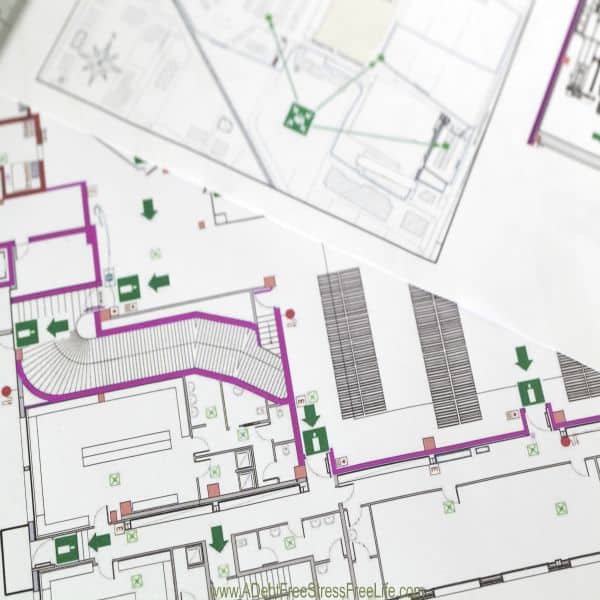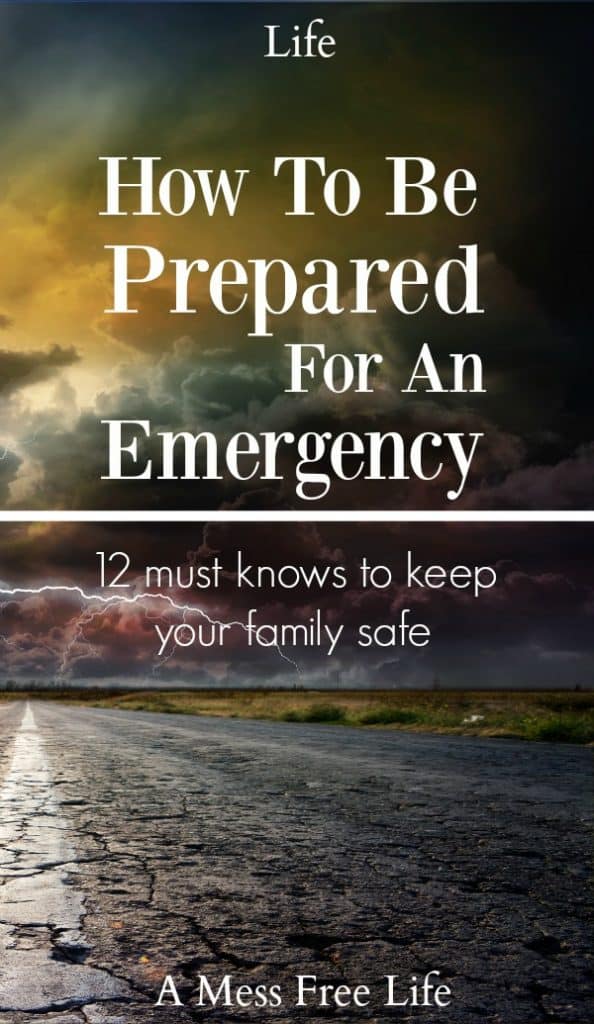A Mess Free Life may collect a share of sales or other compensation from the links on this page.
With fall right around the corner, now is the perfect time to focus your attention on emergency disaster preparedness. All month long I’ll be focusing on certain aspects of emergency disaster preparedness so you can ensure your family is well prepared in case of a catastrophe. I’ll share useful information, tools, and resources to help you be prepared!

Table of Contents
EMERGENCY DISASTER PREPAREDNESS
A few years ago, I had this nagging feeling we might experience a tornado in Massachusetts. Back then, tornadoes were not commonplace for us here in the Northeast corner of the US.
I don’t know why I had this feeling, but I did. I started to think about what I would do if we had an alert for a tornado and how I would protect not only myself but my elderly mother who suffers from dementia and lived with me at the time.
I thought about this for some time and came up with a plan of how I would get my fragile mother into the basement and then protect her with cushions and blankets. I would then secure her so she wouldn’t get sucked up into a funnel cloud, never to be seen again.
Some of my friends thought I was crazy but lo and behold, several weeks later, we did indeed have a tornado in Massachusetts. Luckily it didn’t strike my neck of the woods, but I’ve never forgotten my plan and last year when a tornado warning was issued for my part of the state, I had my plan in place and was ready to implement it.
Since I developed my plan for a tornado, we seem to get alerts for them every single summer without exception. I guess it’s become the new norm.
Planning is essential to ensure you know what to do in any emergency situation.
The Department of Homeland Security, the Red Cross, the Centers for Disease Control and Prevention and many other organizations and blogs have a wealth of information on the topic.
To keep things as simple as possible, I’ve narrowed it down a bit.
KNOW WHAT TO EXPECT
Living in California? You’ll probably not have to worry about a major hurricane. But if you live in the North East you’ll likely find yourself dealing with one of mother nature’s biggest culprits of damage. Part of being prepared is knowing exactly what kind of disasters you and your family might face AND knowing how to respond in each situation. The Red Cross has a list of possibilities depending on where you live. If you think you live somewhere were disaster never strikes. Think again – you’re probably wrong.
LEARN EVACUATION ROUTES AND SHELTER LOCATIONS
Do you remember Hurricane Katrina and all the people sitting on top of their roofs sweltering in the sun and begging to be rescued? You don’t want to find yourself in a similar situation. The time to figure out where to go is now, not in the middle of the disaster. Evacuations are pretty common in certain areas, particularly in the coastal regions, so it would be a good idea to know the details ahead of time.
Make sure you evaluate the risk for where family members work and children go to school.
Once you understand your risks, gather the family and develop your plan.
Read: Planning for A Disaster When You’re Not At Home
THINGS TO CONSIDER WHEN DEVELOPING YOUR PLAN
YOUR FAMILY EMERGENCY EVACUATION PLAN
Start with an evacuation plan for your home and then determine an evacuation route. Here’s how:
- Draw up a floor plan with two escape routes from each room. Make sure children know the ways. Post a map by the door so kids can grab it and go. If one route is out a window, make sure you have an appropriate escape device to aid in leaving the second floor.
- Establish a place to meet outside the house and have alternate meeting locations in the neighborhood.
- Have a full tank of gas, proper clothing, disaster supplies, important documents, and a supply of cash ready to go with you.
- If possible, secure your home as best you can.
- Make sure you have a map of your community with all emergency evacuation routes.
Read: Food Storage Survival Tips
FAMILY COMMUNICATION
- Agree on an out-of-town contact in case local communications are down.
- Make a family contacts’ card for each family member with contact information.
- Program “ICE” (In Case of Emergency) contacts in all of your cell phones.
- In an emergency, go to the Red Cross Website, where you can register yourself as safe and also search for family members.
- Sign up for community alert services that will send you instant text or e-mail alerts for local emergencies.
DETERMINE IF YOU’LL SHELTER AT HOME OR NOT
In most cases when severe weather strikes, staying at home and taking the necessary precautions will be the best choice possible for you and your family. Always follow the instructions given by emergency personnel. If you are asked to leave, follow the guidance of local fire and police.
The ready.gov/september is full of excellent resources and templates to help you create an emergency preparedness plan.
They have a Family Communication Plan for Parents template and a Family Communication Plan for Kids template that you can download, fill in, and train your family to the plan. It’s an excellent resource!
SIGN UP FOR EMERGENCY ALERTS
You can get alerts on your cell phone if you haven’t already disabled them. I know the deafening noise can be startling and annoying, but this is THE BEST WAY to learn about emergencies in your area. And, heck, don’t lie – I know you’ve got your phone on you at all times.
The Emergency Alert System broadcasts over the radio and television but if power is down, don’t rely on it. If you think you’ll get your information from social media, remember your Internet connection could be lost or disrupted in an emergency.
NOAA weather radios and radios that will work without power are always your best bet.
Resources: The Ten Best Survivalist Gifts Under $25
LEARN WHAT TO DO IF NOT AT HOME
You may not be at home when disaster strikes. In the case of an emergency, you should be prepared to react from different locations, including your workplace or car. Most of this is pretty basic stuff — again, know your evacuation routes, communication plan and how you’ll receive the emergency notification. Have a plan for reconnecting with your children who may be at school, daycare or after-school activities. Talk to schools to see how they will communicate with families in an emergency, if they have a shelter-in-place plan and where they will go if they are forced to evacuate.
HAVE A KIT
Having necessities like food, water, first aid supplies and other emergency equipment like flashlights and duct tape is a good idea to have on hand and assembled and ready to use, not scattered all over the house. You can see the full list of tips and options on the FEMA website. Check your kit regularly and make sure everything is in working order and that nothing is missing or expired in the kit.
You can also buy kits on Amazon.com that have pretty much everything you’ll need.
Read: Be Prepared When Disaster Strikes: Build A Kit
SOME PEOPLE MAY REQUIRE SPECIAL CONSIDERATION
Kids, infants, people with disabilities and seniors may all need special considerations while planning for an emergency. If you or a family member need medication or special equipment, make sure you have a plan in place to bring it with you.
Work together with neighbors about how you can help one another in a disaster, and check on each other in case of an emergency.
DON’T FORGET TO PLAN FOR YOU PETS
The goal of emergency preparedness is to keep everyone in the family safe, and that includes your pets. Never leave your pet behind if you have to evacuate. Most public shelters don’t allow pets, so try to leave to a family or friends home. Keep a pet emergency kit on hand with food and medications. Microchip your pets so that if lost they can be identified and returned to you.
LEARN THE SKILLS THAT MIGHT COME IN HANDY
Knowing CPR or how to use a fire extinguisher or how to perform basic first hand might come in handy some day. Get trained in CPR and first hand, which might save a life. Also learn how to shut off utilities in your house in case of a disaster that may damage gas, water, well or electrical lines.
CONCLUSION
When it comes to emergency disaster preparedness you can never be too prepared. Disaster will strike sometimes when we least expect it and other times we’ll have fair warning. Either way, being prepared could be the difference between saving or losing a life. Get your Emergency Disaster Preparedness information and plan together today and be ready for anything.




